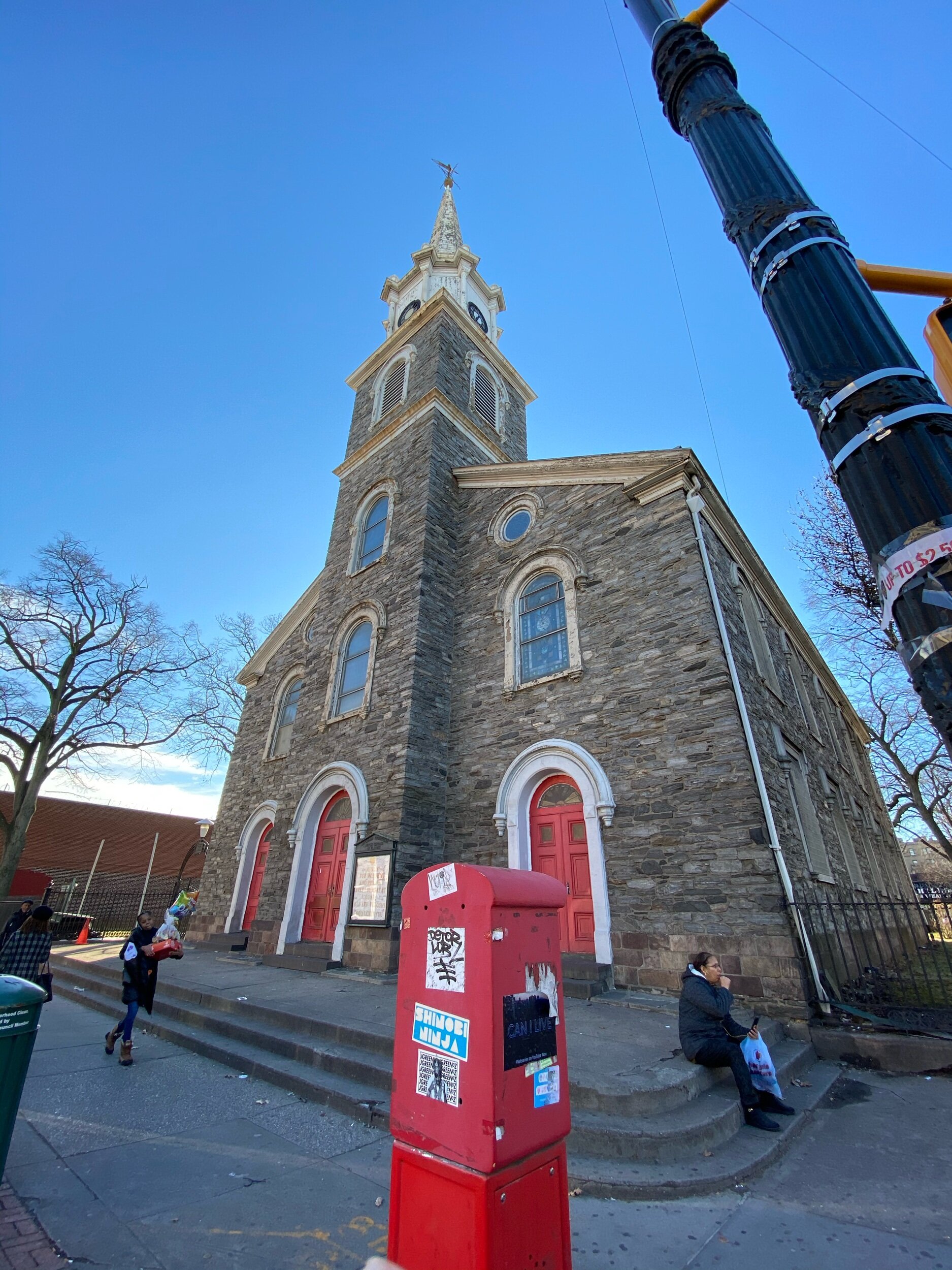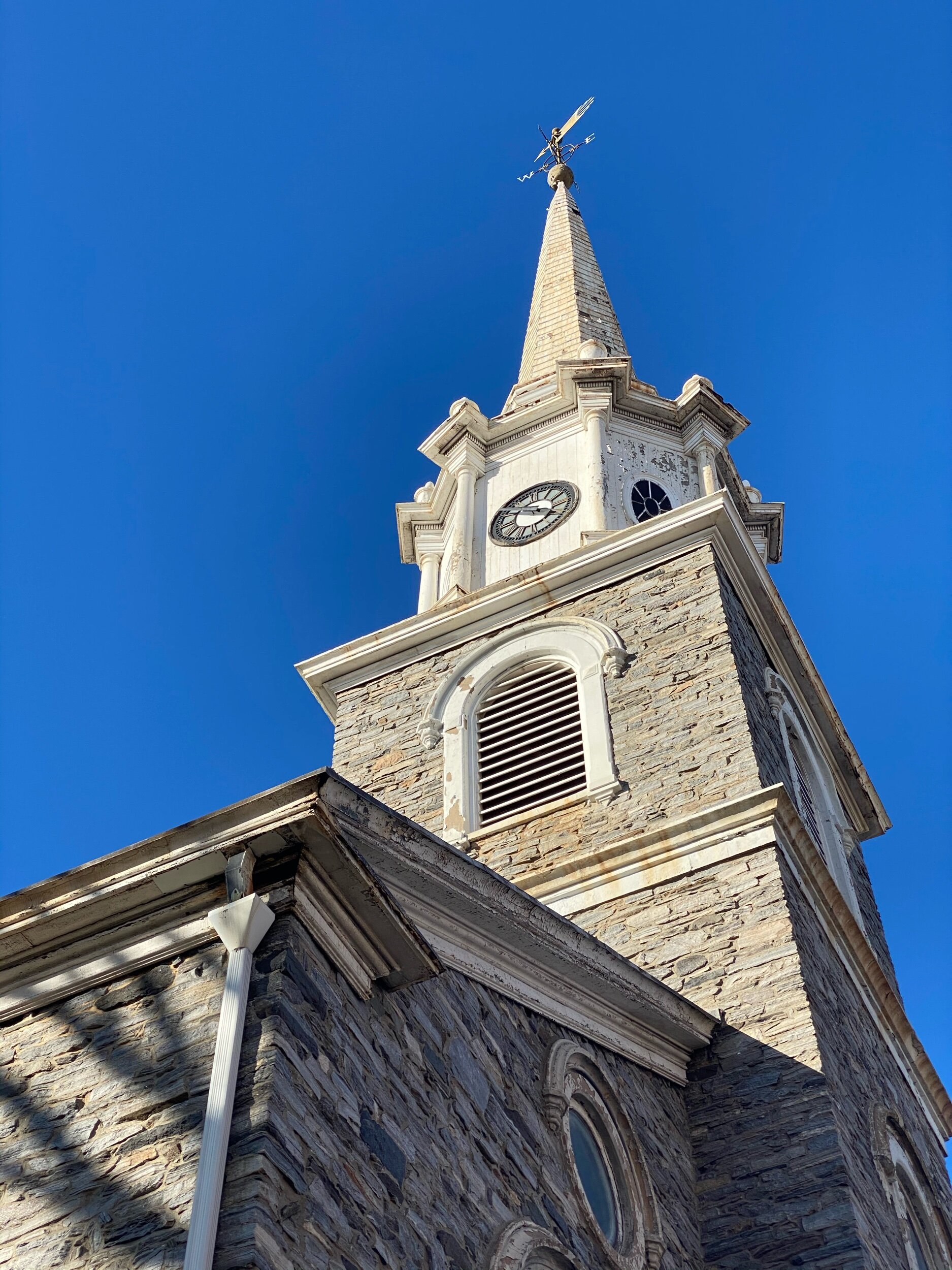The Dutch Reformed Church: OG Flatbush Landmark
By any measure, the Flatbush Reformed Dutch Church is “thee” most important building in Flatbush history, and astonishingly, it’s still with us.
The site, at the corner of Flatbush & Church Aves, has been the site of a church longer than any other in NYC — since 1662, when it was at the center of a tiny settlement of Dutch farmers. Originally, it was the heart of a rural community, and for a long time, the only church we had, no matter where you came from. Black farmers worshipped with the white landowners who enslaved them (but not alongside — they made the Black people sit in the balcony). And when Flatbush split over the Revolutionary War, both sides still held their services at the church.
Those who worked at the church performed all kinds of duties, including (at one time or another), schoolmaster, town historian, comforter of the sick (when little was known about medicine), and even grave digger. One former church member, Sam Anderson, reminisced in 1898:
I remember well Dominie Schoonmaker’s Dutch sermon and I also remember John Antonidas, who was sexton, chorister and grave digger. It was also his duty to go around to give death notices and invite relatives and friends to the funeral services. At that time it was looked upon as a slight if you knew the party who had died and was not asked to be present when he or she was laid at rest. I once heard about an old Dutch woman who, while she was standing at her front gate, saw Master John Antonidas pass on his rounds without stopping at her house. She shouted after him, “I’ll have a funeral some day and then I’ll know who to invite!”
Underneath and behind the church is the resting place of approximately 1,500 bodies, most of which never had gravestones. After the Revolutionary War’s Battle of Brooklyn (which took place basically up the street), many of the bodies were taken to this graveyard and buried in unmarked graves. Enslaved people may have also been buried in unmarked graves, which was often the case back then, although three were given tombstones with their first name only: Flora, Cato, and Diana. The majority of the grave markers in the cemetery belong to Dutch families. Although the earliest Dutch colonists were entombed in the basement of the church (it was custom, and open graves were often robbed back then), their ancestors were buried in the churchyard. Today, the tombstones, many of which were constructed of brownstone or limestone, have mostly worn away. An effort undertaken in 1913 to record and translate the grave markers helps preserve what stones were there.
Although most of the graves are illegible or in disrepair, they’re still in neat rows, and the grass stays mowed. The cemetery is hidden from the street noise and eerily peaceful. Occasionally, the gate is open on Sundays. If you happen to catch it, creep in sometime, peep that steeple, and think deep thoughts about everyone else who’s looked up at it through the years.
Flatbush Dutch Reformed Church Timeline
1630s–1650s - Laymen who the Dutch called krank-besoeckers or ziekentroosters (I LOVE IT) read scriptures for the settlers and tend to the sick.
1654 - The church gets its first minister, called a domine in the Dutch Reformed tradition. Domine Johannes Theodorus Polhemus spends 20 years commuting between churches in Flatbush and the Flatlands and writing letters to Stuyvesant begging for enough money to feed and house his family. Stuyvesant forces the settlers to tithe.
Dec 1654 - Peter Stuyvesant orders a church built on the site to serve all of the Dutch towns in future-Kings County
1662 - First church built on the site is finished. One story and made of wood, it’s laid out in the shape of a cross.
1699 - A stone structure is built in its place, mostly from stones from nearby fields gathered by locals, along with two giant oak columns that hold up the roof. It has vaults underneath for the dead.
1759 - Flatbush is so divided leading up to the Revolutionary War that it brings in a second minister. The two ministers — one supporting the rebels and one supporting the British — share the church, each basically having their own congregations who refuse to speak to each other.
1776 - Casualties from the Battle of Brooklyn are buried under the church. Rebel men who own land in the area are brought to the church and forced to pledge their loyalty to the British crown. The British will occupy Flatbush for seven more years, until the end of the war.
1793 - Excited that the British have left town, and sick of their church’s roof falling apart, villagers begin work on the third and final church at the site, using the same foundation from the stone church
1796 - The third and final church is completed. It still stands on the site today.
1824 - Domine Schoonmaker dies, marking the end of sermons being preached in Dutch at the church
c1860s - Rounded lintels (breams) installed around the doors and windows and clock added to the steeple
1887 - The apse is added in the back to accommodate the organ and choir loft
1889–90- Stained glass windows from the studio of Louis Comfort Tiffany are installed. The ones on the upper floor depict the early Dutch settlers of Flatbush
c1890s-1900s - The informal road known as Church Lane on the west side of Flatbush Ave (because it was by the church) and East Broadway on the east side of Flatbush Ave (because it was a broad street or “way” on the east side of Flatbush) are combined and named Church Ave
1966 - The Flatbush Dutch Reformed Church is designated an official NYC landmark
1983 - The church is added to the National Register of Historic Places
2022 - Renovation work is completed on the steeple, doors, and windows, making the stained glass even easier to see from the street
The Flatbush Dutch Reformed Church as seen from the cemetery, in 2020. The polygon-ish addition to the back (called the apse) was added in 1887 and houses the church’s organ.
This photograph of the Dutch Reformed Church was taken by George Bradford Brainerd in 1877, when Flatbush Ave was still mostly a dirt road was tracks for horse-drawn trolleys. (Brooklyn Museum Collection)
Photo of the church by Eugene Armbruster sometime in the 1920s-30s. It seems to have a lot of ivy at this point! (photo: New York Historical Society)
Once the center of a rural village, the Dutch Reformed Church of Flatbush is now surrounded by traffic and people.
Dutch governor Peter Stuyvesant told the Dutch settlers to build a church on this spot back when Manhattan was called New Amsterdam. The church served numerous community functions beyond preaching the gospel.
Flatbush resident HP Lovecraft called the cemetery of the Dutch Reformed Church an "iron-railed yard of Netherlandish gravestones" in his short story ““The Horror at Red Hook.” It’s eerily peaceful inside.
A list of Dutch gravestones in the cemetery made by Gertrude Lefferts Vanderbilt around 1900. Most (if not all) have been lost to time.
Monument to a soldier lost in the Civil War with Erasmus Hall in the background.















When telephones were the latest new-fangled tech in Flatbush, including a rundown of old Flatbush exchange names.